NVIDIA’s GeForce GTX 590: Duking It Out For The Single Card King
by Ryan Smith on March 24, 2011 9:00 AM ESTMeet The EVGA GeForce GTX 590 Classified, Cont.
Now that we’ve had a chance to discuss the GTX 590 reference hardware, let’s touch on the rest of EVGA’s package. As we previously noted the EVGA GeForce GTX 590 Classified is being positioned as a premium product with a $30 price premium, so let’s see why.
We’ll start with the box—the box EVGA is using is quite simply enormous. EVGA will be selling both single GTX 590s and pairs of GTX 590s using the same box, so the resulting box is big enough to carry two cards. Presumably this isn’t being sold in any retail stores, as a result the box is nearly blank save for the product name on the front.
In order to sell the idea that this is a premium product, EVGA is also packing in some extras with the card. Honestly there’s probably nothing in here that’s going to be of great utility to you except possibly the mouse pad, but clearly EVGA thinks otherwise:
- EVGA Shirt (XL)
- EVGA Poster
- EVGA Branded Gaming Surface (XL Mouse Pad)
- 2x 6pin-to-8pin PCIe power adaptors
- Display adaptors: DVI-to-VGA, DVI-to-HDMI, miniDP-to-DP
- Driver/demo/utility CD
- Non-generic GTX 590 Quick Start Guide
- Redemption offer for 3DMark 2011 Advanced Edition
EVGA is offering up their usual suite of overclocking tools with the GTX 590, however only EVGA Precision is on the disc. EVGA OC Scanner and ELEET can be downloaded from EVGA’s website.
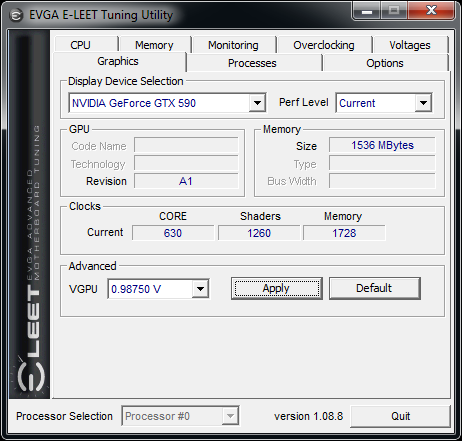
Of the software tools we’ll start with ELEET, as this is the only tool we haven’t covered before. EVGA has had ELEET for some time now for their motherboard business, as it’s their principle motherboard overclocking tool. However at the end of last year they added GPU voltage control through the utility, finally allowing users to overvolt their GPUs using only EVGA tools. We’re glad to see EVGA went with a less-is-more approach with the design of the utility, ditching any funky skinning and focusing on usability. One thing ELEET does that we have not seen on any other utility is that EVGA allows for controlling the voltage for more than just 3D Game clocks; idle and low-performance voltages can also be controlled. We’re assuming the purpose here is to undervolt those modes rather than to overvolt them, as the latter is counterproductive.
At this point ELEET’s only notable weaknesses are related to the fact EVGA implemented voltage control separately from EVGA Precision’s overclocking support. As a result you need to launch ELEET separate from Precision to set any voltages if your overclocked settings require overvolting, and at the moment ELEET does not have any kind of profile support, meaning you have to manually dial in the voltages on every boot. This isn’t utility breaking, but there’s a clear potential for annoyance. EVGA tells us they will be fixing this in the future.
Update: April 2nd, 2011: Starting with the 267.91 drivers and release 270 drivers, NVIDIA has disabled overvolting on the GTX 590 entirely. So while everything we've written about ELEET remains, with the GTX 590 Classified it is effectively rendered obsolete.
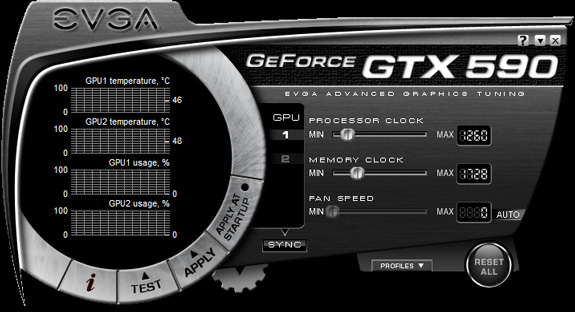
The next utility in EVGA’s suite is of course EVGA’s fantastic EVGA Precision overclocking tool. Based on the famous (and now discontinued) RivaTuner, Precision is a custom-skinned and up to date utility based on RivaTuner technology. It features per-GPU overclocking controls, an OSD overlay, and hardware monitoring/logging. Alongside MSI’s Afterburner, we believe it sets the gold standard for GPU overclocking/monitoring utilities.
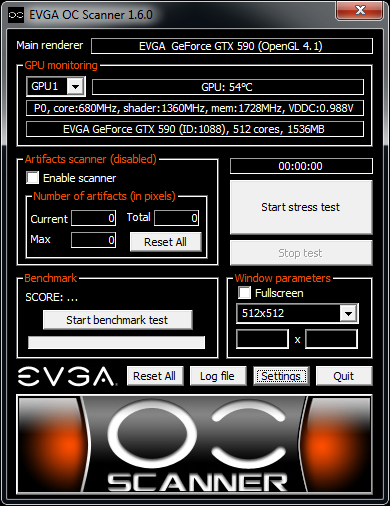
The final utility in EVGA’s suite is the EVGA Overclock Scanner. In a nutshell, the OC Scanner is a load-generating utility (ala Furmark) which rather than generating a moving image generates a static image. By generating a static image it’s possible for the software to identify any rendering errors in the image that would be indicative of a bad overclock. Or in other words, if you’ve overclocked your card too far, this utility will let you know. With the wider range of overclocking options afforded by ELEET, OC Scanner takes on an additional degree of importance for establishing both stability and safe operating temperatures, nicely rounding out EVGA’s software suite. All told the suite should cover 99.9% of most users’ overclocking needs.
Wrapping things up, as is customary for their high-end cards, EVGA is offering a lifetime warranty for the GTX 590, so long as the card is registered within 30 days. Notably overclocking does not void the lifetime warranty (this turned out to cause quite a bit of commotion with the 6990). Altogether, the entire EVGA GeForce GTX 590 Classified package has an MSRP of $729.


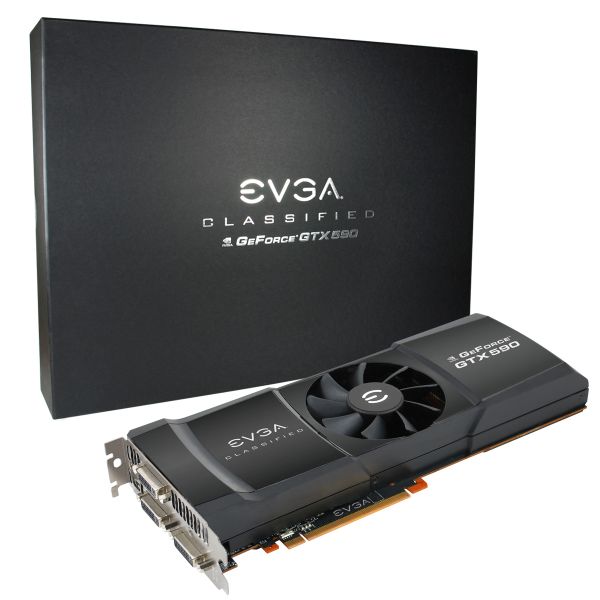
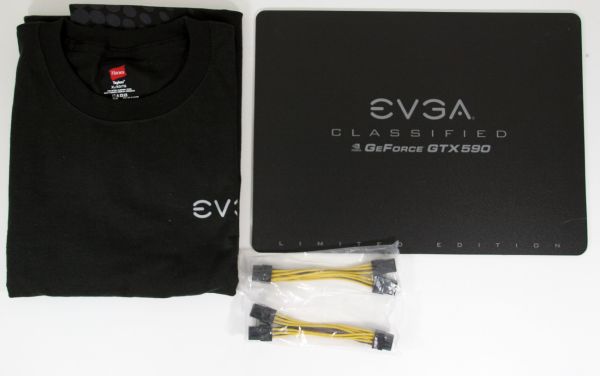








123 Comments
View All Comments
Abot13 - Saturday, March 26, 2011 - link
Well there is advertising and advertising. Asking multiple monitor manufacturers to supply sets of screens in order to test them for multi monitor setups, where the best sets will be used for a longer test period to see how they keep up over time, doesnt interfere with your journalistic integrity, bit for the manufacturers the cost can be written of as PR/advertising costs.in the end your readers will get the information they want, your integrety will be intact and we also will find out what the best monitors are for multi monitor setups.
Shouldnt be that hard now should it?
PrinceGaz - Friday, March 25, 2011 - link
Once you are dealing with framerates above about 80fps at the highest resolutions and quality settings, multi-monitor is one option, or it is time to start cranking up the anti-aliasing as the results are otherwise irrelevant.With one card doing 100fps and another managing 140fps in a game, the best card for that game is the one which is cheapest even if only slightly, unless you can do something to bring the framerates down in a useful way, and higher AA than 4x is the way to go.
Ryan Smith - Friday, March 25, 2011 - link
As a general principle I agree, however 8x AA really doesn't do anything for IQ. I'd rather turn on SSAA/TrAA/MLAA, however AMD and NVIDIA do not have a common AA mode beyond DX9 SSAA. So for DX10/11 titles, MSAA is still the lowest common denominator.DarknRahl - Thursday, March 24, 2011 - link
I agree. Anandtech always seems to have a nvidia bias to their video card reviews.It sticks in the craw as I dig all their other reviews for other products but video card wise I go elsewhere.
B3an - Thursday, March 24, 2011 - link
No they dont. It just that for some reason AMD attracts more morons that like to moan about these non-existent things. And i own AMD cards before you say anything else stupid.softdrinkviking - Sunday, March 27, 2011 - link
100% agree. i own an AMD card too, and i felt like anandtech was extremely positive about the 5800 series when i bought that card.it also looks like they are leaning towards the 6990 vs the 590 in this very article. to paraphrase... the 6990 is going to be better for current new games and future games, but the 590 seems to do a bit better with older titles and new games played at lower resolutions.
i don't understand how anyone could think that makes them nvidia biased. it boggles the mind.
compvter - Thursday, March 24, 2011 - link
Finnish site called muropaketti did some 3x display tests with these new cardshttp://plaza.fi/muropaketti/artikkelit/naytonohjai...
and for your question i would like to answer with other question: Why buy faster cpu if you won't need faster at the moment? Granted there is no limitations like dx compatability, but still you can use your gfx card quite a while. Im still using 3870x2 card (3 years), mainly because there are so few dx11 games.
VoraciousGorak - Thursday, March 24, 2011 - link
For the "hype" they were throwing out with that video preview, I thought they were going to pull a fast one and launch a GeForce 6-series. But a teaser video for a super-enthusiast GPU using existing tech that'll be so rare I'll probably never physically look at one in my lifetime?Color me disappointed.
fausto412 - Thursday, March 24, 2011 - link
yeah.those 700 dollar cards are only to be bought by a rich few.
Improve the $400 price range...that's as high as i'll go these days.
Red Storm - Thursday, March 24, 2011 - link
... are you guys not testing these cards at multi-monitor resolutions? You said yourself in the review that these are marketed towards the high end. Well, the high end isn't just 30" monitors. Multi monitors boast a higher resolution and I think it's important to know how well these dual GPU monsters perform at the level they are marketed towards.